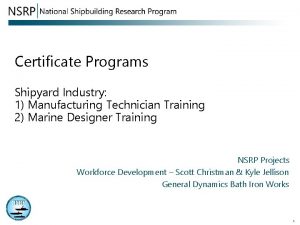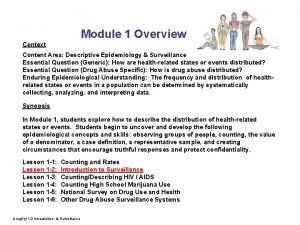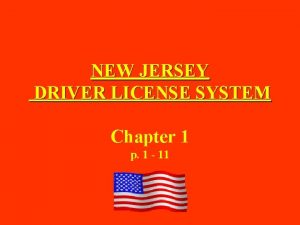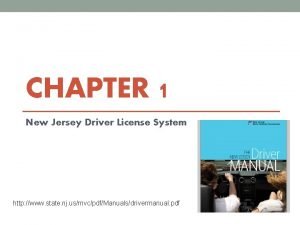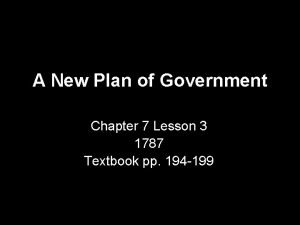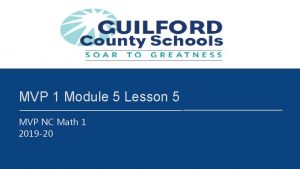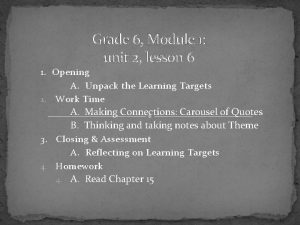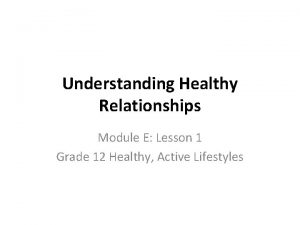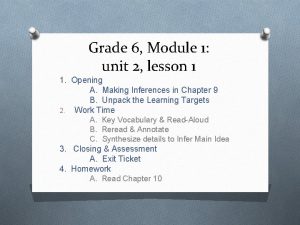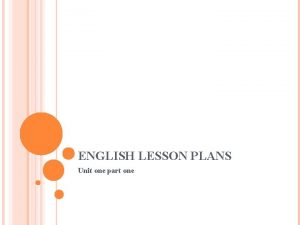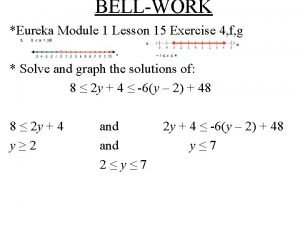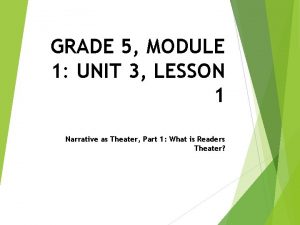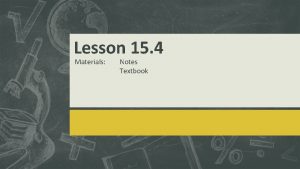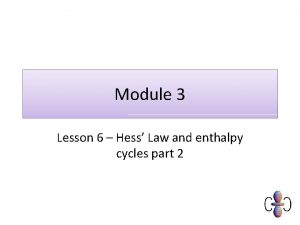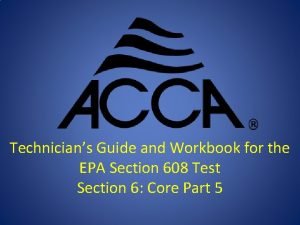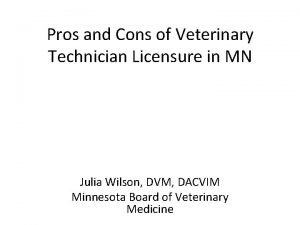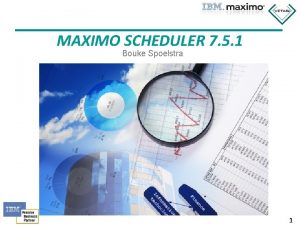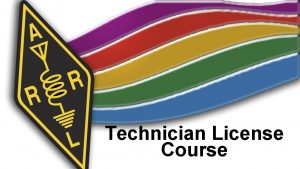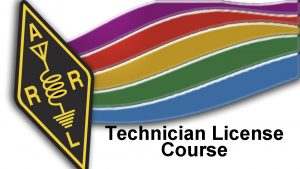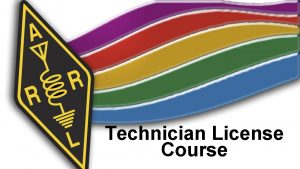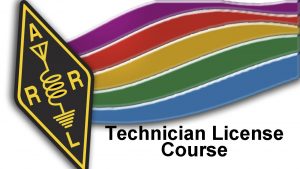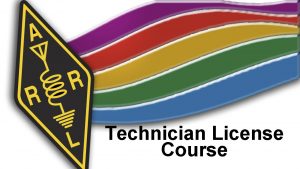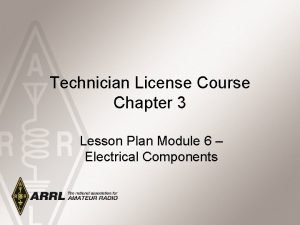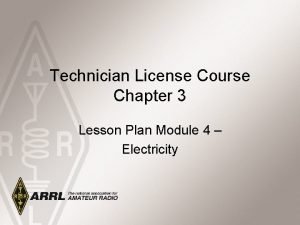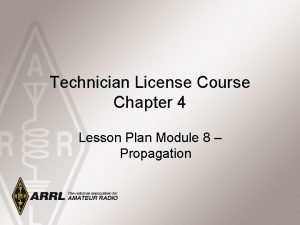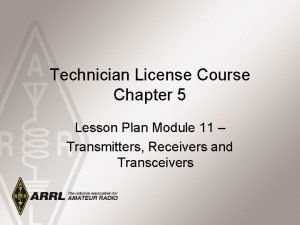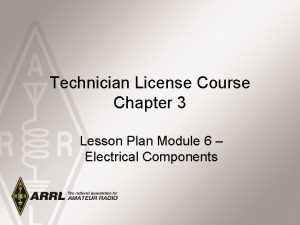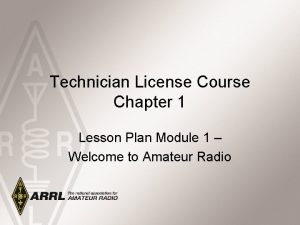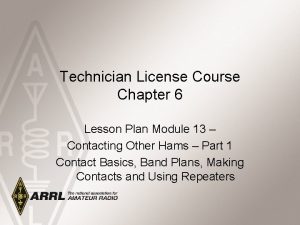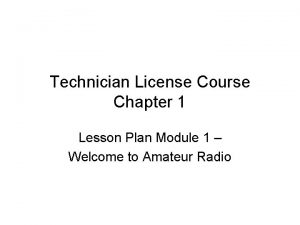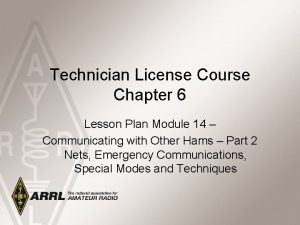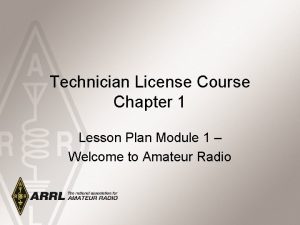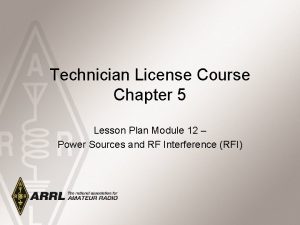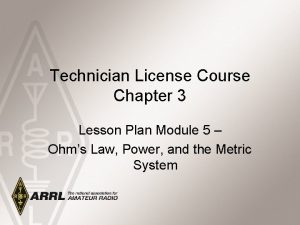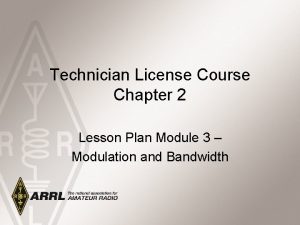Technician License Course Chapter 6 Lesson Plan Module




























- Slides: 28

Technician License Course Chapter 6 Lesson Plan Module 13 – Contacting Other Hams – Part 1 Contact Basics, Band Plans, Making Contacts and Using Repeaters

The Typical Telephone Conversation • Greeting • Identify who is participating • Exchange information, generally taking turns • Salutations • End the conversation 2014 Technician License Course

The Typical Ham Contact (QSO) • Greeting • Identify who is participating • Exchange information, generally taking turns • Salutations • End the conversation 2014 Technician License Course

Radio Manners • Speak clearly and distinctly • Remember – you can’t see the other person talking! • Use phonetics when needed • Assume all communications are public – choose topics accordingly 2014 Technician License Course

Radio Manners • Before transmitting, be sure the frequency is clear and you are authorized to use it! • Station identification (10 -minute rule) • Frequencies are shared • No one has a prior claim to a frequency • Schedules, nets, pre-planned events • Be flexible, always have a “Plan B” 2014 Technician License Course

Radio Manners • Signal reports • Power level • RST • Avoid excess power • Location (QTH) • Grid locators – Readability (1– 5) – Strength (1– 9) – Tone (CW only 1– 9) – “Your signal is 58” 2014 Technician License Course

Radio Manners • Advice and assistance • Radio and antenna tests or checks • Ham radio is self-regulated • ARRL Official Observers • Logging contacts – on paper or computer • QSLs and award programs 2014 Technician License Course

Band Plans • A band plan is a formal plan for organizing types of operation on a band – Informal agreement – not a regulation – Intended for normal circumstances – Be flexible in times of heavy band use (contests, special events, DXpeditions) – Always have a “Plan B” 2014 Technician License Course

Making Contacts • Repeater operation • Listen to see how the regulars operate • To announce your presence, just say your call • Respond to a call with the station’s call followed by your own call • Often used by a club or group as a regional intercom 2014 Technician License Course

Making Contacts • Repeater signal reports (examples) • Full-quieting: signal is strong enough that no noise is heard • Scratchy: occasional noise with your signal • Flutter: multi-path from a mobile station • In and out: occasionally copyable but mostly inaudible 2014 Technician License Course 10

Making Contacts • HF on CW or SSB • “CQ” means “I am calling anyone” • To answer give the station’s call followed by your call once or twice • Use of phonetics is common 2014 Technician License Course

Making Contacts • Taking turns • Nets • Roundtables • Shared contacts • Breaking in • Wait for a pause • Give your call 2014 Technician License Course

Making Contacts • Simplex FM • Each user takes turns to transmit • Works for stations close to each other • If you can hear the other station on the repeater input frequency, try simplex • 2 meters: 146. 52 MHz • 70 cm: 446. 00 MHz 2014 Technician License Course

Repeater Review • Specialized transmitter/receiver interconnected by a controller. • Generally located at a high place. • Receives and simultaneously retransmits your signal on a different frequency. • Dramatically extends line-of-sight range. 2014 Technician License Course

Repeater Review – How They Work 2014 Technician License Course

Duplex Communication • Transmitting on one frequency while simultaneously listening on a different frequency. • Repeaters use duplex communications. • Output frequency – the frequency the repeater transmits on and you listen to. • Input frequency – the frequency the repeater listens to and you transmit on. 2014 Technician License Course

Things to Know to Use a Repeater • Output frequency • Frequency offset – And therefore the input frequency • Repeater access tones (if any) 2014 Technician License Course

Repeater Output Frequency • Repeaters are frequently identified by their output frequency. – “Meet you on the 443. 50 machine. ” • Here the specific frequency is used. – “Let’s go to 94. ” • Here an abbreviation for a standard repeater channel is used, meaning 146. 94 MHz. – “How about the NARL repeater? ” • Here the repeater is referenced by the sponsoring club name. 2014 Technician License Course

Repeater Frequency Offset • The offset frequencies (shifts or splits) are standardized to help facilitate repeater use. • There are + and – offsets depending on the plan. • Different bands have different standardized amounts of offset. 2014 Technician License Course

Repeater Access Tones • Prevents accessing multiple repeaters at once. • Subaudible low-frequency tone must be present before the repeater transmitter will turn on. • Tones have various names (depending on equipment manufacturer). – CTCSS (continuous tone coded squelch system) – PL (a Motorola trade name for CTCSS) – Privacy codes or tones – DCS (digital coded squelch) 2014 Technician License Course 20

Repeater Access Tones • Access tones are usually published along with repeater frequencies. • Could also be announced when the repeater identifies. – “PL is 123. 0” meaning 123. 0 Hz • Tones are generally programmed into the radio along with frequency and offset. 2014 Technician License Course

Repeater Control • Repeater identification (Morse code or synthesized voice) • Same ID requirements as you have • Time-out protection • Protects against continuous transmission in the event of a stuck PTT or long-winded speaker • Usually three minutes • Courtesy beep or tone signals time-out timer reset • May have an autopatch system for phone calls 2014 Technician License Course

Common Problems • Off frequency: causes audio distortion • Low batteries: weak signal, audio distortion • Poor location: hear repeater OK, can’t make or maintain contact • Access tone off or wrong: repeater is strong but can’t access it • Repeater drops in and out of your receiver: squelch setting too high 2014 Technician License Course

Digital Repeater Systems • Repeaters linked by the Internet • Use digital audio – Voice Over Internet Protocol (VOIP) • • • Similar to Skype Allows communication world-wide Internet Linking Relay Project (IRLP) Echolink Access codes on system websites 2014 Technician License Course

D-STAR • Both a repeater linking system and a digital voice protocol • DV: Digital Voice mode (voice + 1200 baud data) • DD: Digital Data mode (128 kbps data) • Repeaters linked together worldwide • Call user-to-user based on call sign • Currently an ICOM system • Yaesu and Kenwood also building digital systems 2014 Technician License Course

Practice Questions 2014 Technician License Course

Under what circumstances should you consider communicating via simplex rather than a repeater? A. When the stations can communicate directly without using a repeater B. Only when you have an endorsement for simplex operation on your license C. Only when third party traffic is not being passed D. Only if you have simplex modulation capability T 2 B 12 HRLM (6 -14) 2014 Technician License Course

Under what circumstances should you consider communicating via simplex rather than a repeater? A. When the stations can communicate directly without using a repeater B. Only when you have an endorsement for simplex operation on your license C. Only when third party traffic is not being passed D. Only if you have simplex modulation capability T 2 B 12 HRLM (6 -14) 2014 Technician License Course
 Manufacturing technician license
Manufacturing technician license Manufacturing technician license
Manufacturing technician license Format of micro lesson plan
Format of micro lesson plan C device module module 1
C device module module 1 Situational frontline leadership
Situational frontline leadership Course module sample
Course module sample A gift of chappals mind map
A gift of chappals mind map T junction in english bond
T junction in english bond Course title and course number
Course title and course number Course interne course externe
Course interne course externe Applying for a driver’s license illegally may result in:
Applying for a driver’s license illegally may result in: Chapter 1 the new jersey driver license system answers
Chapter 1 the new jersey driver license system answers Chapter 1 the new jersey driver license system answers
Chapter 1 the new jersey driver license system answers Chapter 1 lesson 1 your total health
Chapter 1 lesson 1 your total health Chapter 7 lesson 3 a new plan of government
Chapter 7 lesson 3 a new plan of government Hardship and suffering during the depression
Hardship and suffering during the depression Module 5 lesson 5
Module 5 lesson 5 Eureka math grade 6 module 1 answer key
Eureka math grade 6 module 1 answer key Practical/logistical issues in relationships
Practical/logistical issues in relationships Grade 6 module
Grade 6 module Module eleven lesson one self check quiz
Module eleven lesson one self check quiz Eureka math algebra 1 module 1 lesson 15
Eureka math algebra 1 module 1 lesson 15 Grade 5 module 1 lesson 1
Grade 5 module 1 lesson 1 Module 15 lesson 1 central angles and inscribed angles
Module 15 lesson 1 central angles and inscribed angles Enthalpy of formation hess law
Enthalpy of formation hess law What is coring in pharmacy
What is coring in pharmacy How long must a technician evacuating refrigerant
How long must a technician evacuating refrigerant Vet tech pros and cons
Vet tech pros and cons Maximo oil and gas scheduler
Maximo oil and gas scheduler
